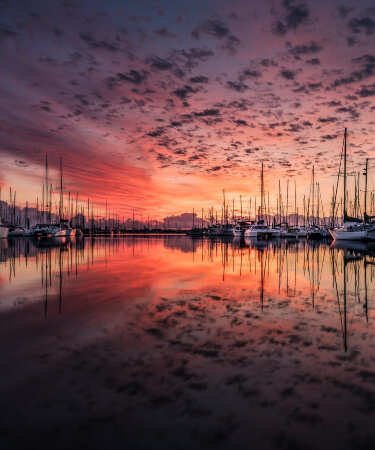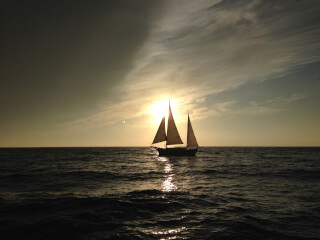Table of Contents
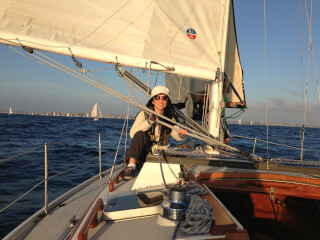
After the Machu Picchu expedition, I devoted more time to sailing and started up with classes once again to get more time on the water. In short order, I took a Docking Endorsement class as well as ASA 104 and ASA 105.
Docking Endorsement, May 2013
Catalina 36 Instructor: Ben
The docking class was awesome. Learned a lot, however the adage “if you don’t use it, you lose it” applies here. I would do it again in a heartbeat, especially since docking seems to be the one aspect of sailing that freaks me out the most.
ASA 105 Coastal Navigation, May 2013
Instructor: Elliot
Unlike the other courses (ASA 101, 103 and 104), coastal navigation was taught through a few classroom sessions and homework. No time on the water. The focus is gaining the ability to explain chart symbols and conventions on U.S. nautical charts, knowing which resources/publications to use, understanding the instruments used to navigate (e.g., steering compass and deviation table, binoculars, protractor, depth sounder or leadline, knotmeter, etc.), converting courses and bearings between true, magnetic and compass.
Just as with the docking endorsement class, if you don’t use it, you lose it. Bluewater Sailing offered opportunities for me to sit in on classes before taking the exam, an offer I didn’t take advantage of at the time, which I regret. A couple weeks ago, Andrew asked me if I could teach him coastal navigation, and I admitted to him that I would need to brush up on it beforehand. In the field of medicine, students are taught “learn one, do one, teach one.”
During this summer, we’ve set aside 1-hour blocks of time each day to focus on sailing knowledge. Usually, this translates to independent study and then we would discuss what we each had learned. Teaching coastal navigation could be a good topic for us to cover over the course of the next few weeks while we’re social distancing at home.
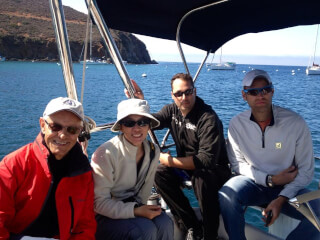
ASA 104 Bareboat Chartering, May 2013
Hunter 41 Faye Instructor: Elliot, Ash
The objective of taking a course in bareboat chartering is to gain the skills and knowledge to act as a skipper or crew of a 30-50 foot boat sailing by day in coastal waters. This would include learning boat systems and maintenance procedures.
Once again, I signed up with Bluewater Sailing for a 2-day course sailing from Marina del Rey to Isthmus Cove of Catalina Island (distance of 62 nm round trip). We boarded a Hunter 41 AC Faye. She has a fin hull with a spade rudder, LOA 40.32 ft, beam 13.25 ft, and displacement of 19,400 lbs. The crew included Bob, Adam, Kevin, me and instructor Ash.
The week before the class, we exchanged emails to discuss provisioning before we set out, with each of us volunteering to handle one meal.
- Adam - lunch Saturday (sub sandwich makings and salad)
- Denise - dinner Saturday (shepherd’s pie)
- Bob - breakfast Sunday (egg scramble)
We met at 7 a.m. Saturday with our gear and drove over to the marina where Faye was berthed for a departure time of 9 a.m. We had a scheduled return of 6 p.m. Sunday.
Weather conditions were sunny with light winds (2 knots), and we found ourselves motorsailing in the morning. Eventually in the afternoon, the wind picked up to 10 knots, however we continued to motorsail given our intention to focus on the sailing topics and preparing for our arrival at Isthmus Cove. The sailing topics covered planning, living aboard, weather, and seamanship.
Isthmus Cove, on the leeward side of Catalina Island, offers 242 moorings and anchorages for over 100 vessels. Bluewater Sailing had arranged the reservation, but on our approach, Ash confirmed our ETA along with the mooring location.
After we picked up a mooring ball, we tidied up and settled in. I began to prepare dinner. In the evening, we hailed a watertaxi and headed for shore to walk around and have drinks at the local watering hole, Harbor Reef Saloon. While there, we sampled their famous Buffalo Milk.
The next morning, Bob prepared a breakfast scramble. While enjoying breakfast in the cockpit, we extended our chat to wait out the fog. After a couple hours, Ash made the decision to depart using the current weather as a teaching opportunity for us: how to sail and navigate in fog.
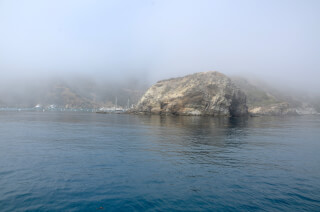
With about 6 knots of wind and 1/4 mile visibility, we took turns on watch at the bow, kept our ears alert for any navigational aids, and sounded a horn every 2 minutes, while motoring at a steady speed and course. Ash spent some time down below hunting for a radar reflector and came up short.
- One prolonged blast at intervals of not more than two minutes is the signal used by power-driven vessels when underway.
- One prolonged blast plus two short blasts at intervals of not more than two minutes is the signal used by sailing vessels.
At one point, a powerboat zoomed by with blatant disregard for caution during the fog, which was all the more reason for us to remain vigilant. These days of GPS, AIS and radar, one might be lulled into an over-reliance on electronics. I am reminded now of that experience where we had to do some old-fashioned dead reckoning by plotting running fixes every 15 minutes and keeping a close record of courses steered (for how long and for what speed).
Little did I know, that this experience would prepare me for sailing in San Francisco Bay in the fog, with much stronger current, chop and wind in the middle of the night.
Sunset Series, Summer 2013
Catalina 34 “Cool Change”
My quest to get more time on the water also led to my participating in the sunset regattas. I signed up for quite a few of these races which are held each Wednesday from Memorial Day to Labor Day. This experience helped me fine-tune sail trim, deploying spinnakers, and sailing wing-on-wing.
I also met Hannah who eventually invited me along to a trip to the British Virgin Islands the following year.
CSC, Fall 2013 through 2014
Catalina 36 Mystic
In the fall of 2013, my friend Mark put me in touch with his sailing club, California Sailing Cooperative. He had been a member for quite some time and mentioned it to me during one of our bi-weekly Texas Hold’em games. There was a waiting list, but given my connection, I was quickly invited to a first test sail in September.
The members of CSC join the club for a variety reasons:
- social interactions, sundowners, dock parties, etc.
- casual, stress-free daysails on the weekends with Captain and First Mate
- experience-based learning for ASA certifications
Since I had already passed several ASA courses, this club gave me an opportunity to get more experience and really dial-in my skills on a decent size keelboat as I was able to get out on the water twice a month. Sometimes if there were last minute cancellations, I would ask to join if I had a free weekend.
From time to time, we had a chance to sail further afield and with different vessels. One of the skippers would charter a catamaran, taking us out to Malibu or another time, the skipper had chartered a smaller racing sailboat out of Long Beach so we can get to know a different marina.
And of course generally in the fall and winter months, we would delight in seeing dolphins swimming in our wake as well as seeing the sea lions sunning on buoys near the shipping lanes.
Members of the club also do their part to clean up the bay. Here is Mark using a boat hook and going through MOB steps to rescue a cluster of mylar balloons.
For those in Southern California, I highly recommend joining CSC. They are a tight-knit group of sailors that enjoy their sundowners, dock parties and Christmas events. Check out the CSC Facebook page for more pictures.
San Francisco Bay, Oct 2013
Beneteau 42
Sue and I became fast friends during our Machu Picchu expedition in the spring of 2013, especially as we toured other ruins in Lima along with Hasmik. In the fall, I had wanted to take a trip up to San Francisco for a foodie tour and decided to spend some time with her. While there, I thought I would book a moonlight sail out of Sausalito with Modern Sailing, an ASA school and club that came highly recommended by Hannah. I met Hannah over the summer while racing in Marina del Rey.
We picked up sandwiches for dinner aboard and set out of the relatively calm bay of Sausalito. The winds soon picked up once we left the protected area and we sailed at a pretty quick clip while the sun set behind the Golden Gate bridge off the starboard.
We continued on past Alcatraz while we saw the moon rise in the distance beyond the Bay Bridge. By then, we were experiencing strong currents pushing us toward Bay Bridge.
Night had fallen and the fog rolled in. We tried to head back, but kept drifting backwards, so we fired up the motor and motorsailed slowly, making little progress as the wind and current kept pushing us back.
With little visibility and no GPS, we resorted to downloading apps on our phones to figure out where we were relative to Alcatraz. At one point, the skipper mentioned making landfall there if we weren’t able to progress further in the next hour.
Sue probably hated me right then and there.
As the night ticked on, we crawled our way across the bay, finally arriving in Sausalito at 2 a.m. Sue drove us back to her house, and we collapsed in our beds.
When I recount this story to friends and family, I receive a sequence of reactions: 1) worry over the tribulation I faced, 2) relief that I made it back safely, and 3) surprise when I tell them I would do it again in a heartbeat because I had a chance to learn to sail under different conditions.
When I told this story to Andrew, he readily agreed with my conclusion. This certainly played out when we experienced sailing together in Greece.
Stay tuned for the final part of our series on Sailing Resume.
Thanks for reading!
Share Sailing Resume Part 2 with your friends:
Stay up to date with our content releases, by subscribing to our RSS Feed or follow us on Facebook and Instagram.
 If you would like to delve deeper into our adventure as it unfolds, please consider joining the Serenade Wind Crew. Our sister site provides more information on what it means to be part of the crew, unlock the pirate’s booty, and receive other exclusive access and benefits.The first 50 members have a gift waiting.
If you would like to delve deeper into our adventure as it unfolds, please consider joining the Serenade Wind Crew. Our sister site provides more information on what it means to be part of the crew, unlock the pirate’s booty, and receive other exclusive access and benefits.The first 50 members have a gift waiting. 